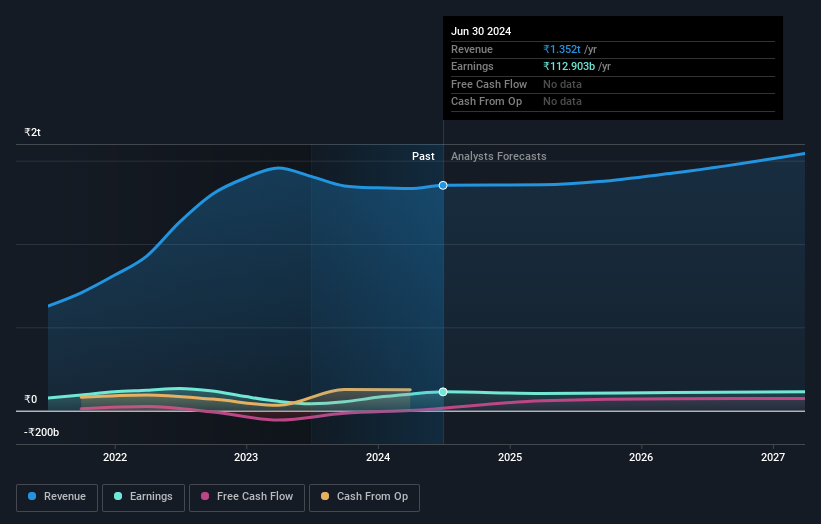GAIL (India) Limited (NSE:GAIL) received a lot of attention from a substantial price movement on the NSEI over the last few months, increasing to ₹241 at one point, and dropping to the lows of ₹211. Some share price movements can give investors a better opportunity to enter into the stock, and potentially buy at a lower price. A question to answer is whether GAIL (India)'s current trading price of ₹230 reflective of the actual value of the large-cap? Or is it currently undervalued, providing us with the opportunity to buy? Let’s take a look at GAIL (India)’s outlook and value based on the most recent financial data to see if there are any catalysts for a price change.
See our latest analysis for GAIL (India)
What's The Opportunity In GAIL (India)?
Good news, investors! GAIL (India) is still a bargain right now according to our price multiple model, which compares the company's price-to-earnings ratio to the industry average. In this instance, we’ve used the price-to-earnings (PE) ratio given that there is not enough information to reliably forecast the stock’s cash flows. we find that GAIL (India)’s ratio of 13.41x is below its peer average of 19.78x, which indicates the stock is trading at a lower price compared to the Gas Utilities industry. Another thing to keep in mind is that GAIL (India)’s share price is quite stable relative to the rest of the market, as indicated by its low beta. This means that if you believe the current share price should move towards its industry peers, a low beta could suggest it is not likely to reach that level anytime soon, and once it’s there, it may be hard to fall back down into an attractive buying range again.
What kind of growth will GAIL (India) generate?

Future outlook is an important aspect when you’re looking at buying a stock, especially if you are an investor looking for growth in your portfolio. Buying a great company with a robust outlook at a cheap price is always a good investment, so let’s also take a look at the company's future expectations. However, with a negative profit growth of -2.1% expected over the next couple of years, near-term growth certainly doesn’t appear to be a driver for a buy decision for GAIL (India). This certainty tips the risk-return scale towards higher risk.
What This Means For You
Are you a shareholder? Although GAIL is currently trading below the industry PE ratio, the negative profit outlook does bring on some uncertainty, which equates to higher risk. We recommend you think about whether you want to increase your portfolio exposure to GAIL, or whether diversifying into another stock may be a better move for your total risk and return.
Are you a potential investor? If you’ve been keeping an eye on GAIL for a while, but hesitant on making the leap, we recommend you dig deeper into the stock. Given its current price multiple, now is a great time to make a decision. But keep in mind the risks that come with negative growth prospects in the future.
With this in mind, we wouldn't consider investing in a stock unless we had a thorough understanding of the risks. Every company has risks, and we've spotted 1 warning sign for GAIL (India) you should know about.
If you are no longer interested in GAIL (India), you can use our free platform to see our list of over 50 other stocks with a high growth potential.
New: Manage All Your Stock Portfolios in One Place
We've created the ultimate portfolio companion for stock investors, and it's free.
• Connect an unlimited number of Portfolios and see your total in one currency
• Be alerted to new Warning Signs or Risks via email or mobile
• Track the Fair Value of your stocks
Have feedback on this article? Concerned about the content? Get in touch with us directly. Alternatively, email editorial-team (at) simplywallst.com.
This article by Simply Wall St is general in nature. We provide commentary based on historical data and analyst forecasts only using an unbiased methodology and our articles are not intended to be financial advice. It does not constitute a recommendation to buy or sell any stock, and does not take account of your objectives, or your financial situation. We aim to bring you long-term focused analysis driven by fundamental data. Note that our analysis may not factor in the latest price-sensitive company announcements or qualitative material. Simply Wall St has no position in any stocks mentioned.
About NSEI:GAIL
GAIL (India)
Operates as a natural gas processing and distribution company in India and internationally.
Established dividend payer and good value.
Similar Companies
Market Insights
Community Narratives




